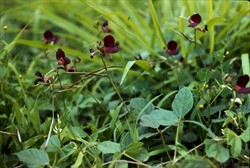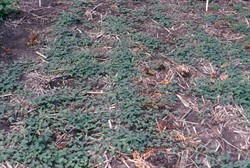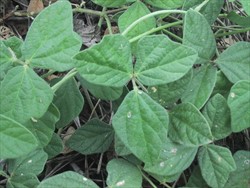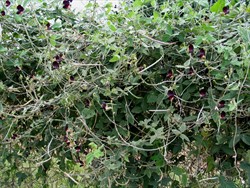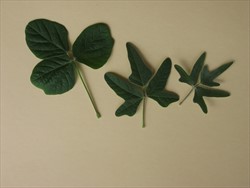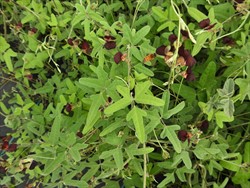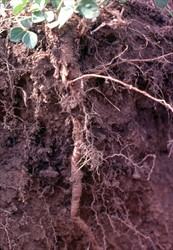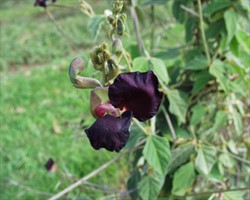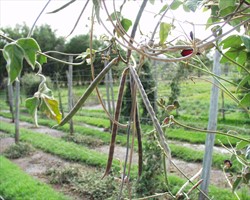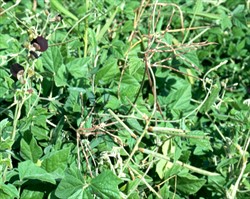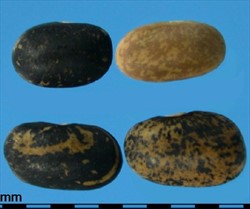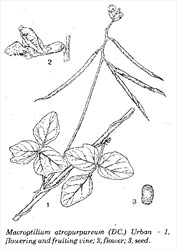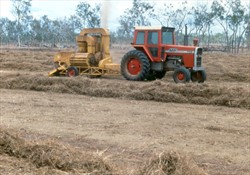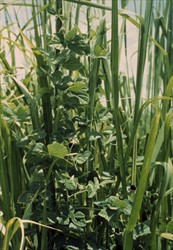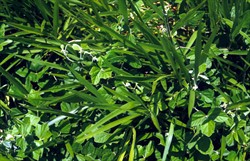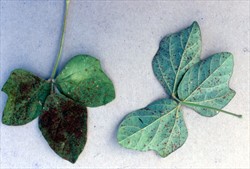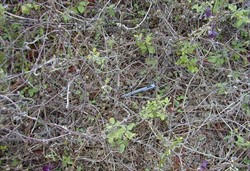Macroptilium atropurpureum
Tropical Forages
Macroptilium atropurpureum (DC.) Urb.
Basionym: Phaseolus atropurpureus DC.
Family: Fabaceae (alt. Leguminosae) subfamily: Faboideae tribe: Phaseoleae subtribe: Phaseolinae.
Perennial herb with deep, swollen taproot and trailing, climbing and twining stems. Stems at the base of older plants fibrous, >5 mm diameter; younger stems mostly 1‒2 mm diameter, pubescent to densely pilose with white hairs; occasionally forming nodal roots under ideal conditions. Leaves trifoliolate; leaflet blades 2‒7 × 1.5‒5 cm, darker green and finely hairy on the upper surface, grey-green, pubescent on the lower surface, with leaf margins sparsely to densely, finely ciliate. Lateral leaflets ovate to narrowly elliptical, obtuse, mostly with one or two, shallow to deep lobes on the outer margin; terminal leaflet rhomboid, with or without single lobe either side. Inflorescence a raceme comprising 6‒12 often paired flowers on a short rachis; peduncle 10‒30 cm long. Flower: calyx campanulate-tubular, hairy, tube 8‒9 mm long and 3 mm wide, corolla with conspicuous wings 15‒17 mm long, deep purple with reddish tinge near base; standard smaller than wings, obovate deltoid at base, reflexed, yellow-green with a purple tint; keel pink, forms a complete spiral; white flowered forms rare. Pods straight, linear-cylindrical, acuminate-beaked, pubescent, 5‒10 cm long, 3‒5 mm diameter, containing up to 12 (‒15) seeds. Pods dehisce violently (shatter) along both sutures when ripe. Seeds flattened ovoid, 4 × 2.5 × 2 mm, speckled, light brown to black. 75,000 seeds per kg.
Similar species
M. atropurpureum: no whorl of bracts at the base of the peduncle.
M. bracteatum: whorl of bracts at the base of the peduncle.
Asia: 紫花大翼豆 zi hua da yi dou (China); サイラトロ sairatoro, クロバナツルアズキ kuro bana tsuru azuki (Japan); thua-siratro (Thailand)
English: atro, siratro, purple-bean, purple bush-bean, surple-bean
Europe: macroptilium à fleur pourpre (French); Purpurbohne (German)
Latin America: choncho, conchito, frijolillo; habichuela parada (Puerto Rico)
Native:
Northern America: USA (Texas); Mexico
Caribbean: Bahamas; Cuba; Guadeloupe; Hispaniola; Martinique; Puerto Rico; St Lucia
Central America: Belize; El Salvador; Guatemala; Honduras; Nicaragua; Panama
South America: Brazil; Colombia; Ecuador; French Guiana; Peru
Naturalized:
Widely cultivated and naturalized throughout tropics and subtropics
Forage
Mainly used for permanent and short-term pastures. While best suited to grazing, it can also be used for cut-and-carry or conserved as hay (usually with an associated grass), although the twining habit can make harvesting difficult. Its value as a protein bank for dry season feeding is reduced by its tendency to drop leaf under very dry conditions.
Environment
It is also used for soil conservation (re-vegetation/stabilisation of earthworks in cuttings and on embankments), and as a cover crop, fallow crop (including after lowland rice), or as a forage crop sown with upland rice. When used as a short-term ley legume in sorghum crops, the nitrogen benefit can persist for up to 3 crops of sorghum. However, large populations of the twining legume can regenerate from hard seed in the soil, creating difficulties in grain harvest.
Soil requirements
Occurs on a wide range of soils ranging from dark cracking clays, to yellow and red clays, to littoral dunes, red sands and gravels. Soil reaction at collection sites ranges from pH (5.5‒) 6.5‒8.0 (‒8.5). In cultivation, 'Siratro' has been successfully established in soils with pH 5.0 (and even as low as 4.5), and in coral rubble (pH 8.5). It thrives in friable soils, but declines fairly rapidly in hard-setting soils. Tolerant of moderate levels of soil Al and Mn, and better tolerance of salinity than most tropical forage legumes. While preferring deep, well-drained soils of moderate fertility, some collections have been made at poorly drained sites and on infertile soils.
Moisture
Occurs in areas with annual rainfall from (120‒) 650‒1,500 (‒2,500) mm. In cultivation, it is mostly sown in areas with rainfall between about 700 mm and 1,500 mm. Leaf disease can be a problem in higher rainfall environments. It is well adapted to drought, possessing a deep taproot and the ability to minimise evapo-transpiration by virtue of pubescent leaves, and reduction in leaf size and shedding of leaves in response to the onset of dry conditions. While generally intolerant of flooding or waterlogging, it can adapt to poor drainage by developing an extensive, shallow root system in the better-drained surface soil.
Temperature
Found in areas from 30º N in Mexico to about 22º S in Brazil, and at altitudes from near sea level in Panama (8º37' N) to 2,100 m asl in Mexico (28º30' N) and 2,900 m asl in Ecuador (1º40' S). Cultivars grow best in the subtropics (to latitude 30º) and higher altitude tropics with warm season growth, achieving best production with day/night temperatures of 27‒30/22‒25 ºC; growth is poor below 18/13 ºC day/night. Leaves are burnt by light frost. More severe frosts kill the plant back to the crowns, but plants recover with the onset of warm, moist conditions.
Light
M. atropurpureum is fairly intolerant of shade, and is best grown in full sunlight. Siratro seedlings do not establish under the dense shade of a closed canopy. Chemical composition and dry matter digestibility are largely unaffected by shade down to 40% sunlight.
Reproductive development
Flowering is initiated in response to the onset of dry periods and to shortening days. Vegetative growth resumes with the return of moist conditions. Pods shatter when mature. Seeds can rot in pods under wet conditions.
Defoliation
M. atropurpureum prefers light stocking rates and/or rotational grazing. A rotational grazing system of 2 weeks on, 4 weeks rest, has given good results in the humid subtropics. Stands deteriorate within a year or two under regular heavy grazing due to loss of bud sites, shorter plant life, reduced seed set, and declining soil seed reserves. Even with judicious management, they tend to become less productive over 5‒7 years. While individual plants may persist for 4 years or more, pastures benefit from periodic spelling (every 2‒3 years) during seed set to bolster soil seed reserves and reinvigorate plants. Contour ripping with a tyned implement can hasten the rejuvenation of stand over simply resting.
Fire
After fire, plants recover well from crowns or stems, and from new seedlings emerging from soil seed reserves.
Guidelines for establishment and management of sown forages.
Establishment
Hard seed levels are often high and seed should be scarified before planting. Mechanical scarification can increase germination from 10% to 80%; treatment with concentrated sulphuric acid for 25 minutes can be used on small samples (seed should be washed thoroughly and dried after treatment). Suction-harvested seed is usually sufficiently scarified by the harvesting process. Seed is best sown at 1‒2 (‒5) kg/ha into a well-prepared seedbed. Seedlings are vigorous and can also establish with minimal cultivation, into herbicide-killed grass, or following a burn. However, the less competition for the developing seedling, the better the establishment. M. atropurpureum has a broad symbiont range for nodulation, and can nodulate effectively on native rhizobia in most soils. If in doubt, seed should be inoculated with 'cowpea' type inoculum such as CB 756 (Australia).
Fertilizer
Additional phosphorus may be required at establishment (20‒30 kg/ha P), and for maintenance (10‒20 kg/ha/yr P) on soils with less than about 8 ppm available phosphorus. The need for other nutrients, particularly K and S, should be monitored by soil analysis or foliar deficiency symptoms. Siratro is responsive to molybdenum, requiring 100‒200 g/ha Mo at establishment on deficient soils, and 100 g/ha Mo every 4‒5 years as maintenance.
Compatibility (with other species)
Combines best with erect or tussock grasses, and legumes requiring similar grazing management. It is less compatible with aggressive creeping grasses such as Paspalum notatum and Digitaria eriantha (pangola).
Companion species
Grasses: Chloris gayana, Cenchrus ciliaris, Megathyrsus maximus, Setaria sphacelata.
Legumes: Chamaecrista rotundifolia, Desmodium intortum, Macrotyloma axillare, Neonotonia wightii, Stylosanthes guianensis var. guianensis, S. hamata, S. scabra, S. seabrana.
Pests and diseases
During periods of high rainfall and high humidity, foliar blight caused by Rhizoctonia solani can reduce leaf yields by 80%. Plants recover with a return to dry conditions. Bean rust (Uromyces appendiculatus var. crassitunicatus) gives rise to many brown pustules on the leaves of susceptible varieties, leading to severe leaf drop and pasture quality decline. 'Aztec' was bred to overcome this weakness in 'Siratro'. False rust (Synchytrium phaseoli) develops during periods of high humidity and can be devastating. 'Siratro' is a known host crop for (Asian) soybean rust (Phakopsora pachyrhizi). Angular leaf spot or grey leaf spot (Phaeoisariopsis (Isariopsis) griseola) can cause moderate to severe leaf loss under cool conditions. Halo blight (Pseudomonas syringae pv. phaseolica), which is carried on, but has little effect on 'Siratro', can infect nearby french beans (Phaseolus vulgaris) causing serious damage to the bean crop. Viruses affecting M. atropurpureum include mung bean yellow mosaic virus and passionfruit woodiness potyvirus. Legume little leaf disease caused by a phytoplasma and spread by leafhoppers (e.g. Orosius orientalis) can kill individual plants but does not cause significant loss. Resistance to the root-knot nematodes, Meloidogyne arenaria, M. hapla, M. incognita, and M. javanica is common in M. atropurpureum, although specific resistances between lines may vary. 'Siratro' is resistant to the burrowing nematode (Radopholus similis) but not spiral nematode (Helicotylenchus dihystera).
Bean fly larvae (Melanagromyza phaseoli Diptera: Agromyzidae) burrow in the stems often killing late-planted 'Siratro' seedlings. The bean leaf roller or long-tailed skipper (Urbanus proteus Lepidoptera: Hesperiidae) attacks 'Siratro' in late summer and autumn. Adults of rough brown weevil (Baryopadus (Leptopius) corrugatus Coleoptera: Curculionidae) feed on foliage, and larvae can severely damage roots.
Ability to spread
'Siratro' is mostly spread by seed, since stolon development is typically very weak. Seed is forcibly ejected from the pod and can be thrown for several metres. It can be spread great distances through water movement and following ingestion by cattle.
Soil seed levels under lightly stocked stands have been measured at 500/m² (67 kg/ha), and 100/m² (13 kg/ha) in heavily stocked stands
Weed potential
M. atropurpureum is now considered a weed of ungrazed areas (e.g. roadsides, waste land, domestic gardens) and can also create problems in sugar cane where the tough climbing stems can interfere with mechanical harvesting. It is regarded as an environmental weed in the northern part of Australia, where it can form dense infestations along forest margins, growing over native shrubs, grasses and young trees, effectively smothering them.
Nutritive value
Nutritive value generally good, although crude protein, mineral content and digestibility can be increased by providing optimal P, S and Mo. CP and IVDMD values of tops varies from about 12% and 45% in older material to 25% and 65% in younger material. Average CP, P and ADF in leaves in the top 15 cm of growth have been measured at 25, 0.26 and 24%, and in stems at 15, 0.22 and 41%, with leaves constituting 76% of the dry matter.
Palatability/acceptability
Readily accepted, although cattle prefer fresh young grass early in the growing season. Siratro is heavily browsed by deer, and quail are attracted to the seed crop.
Toxicity
None recorded.
Feedipedia link
Dry matter
DM yields are mostly in the range of 5‒10 t/ha/yr, although yields are lower under more regular defoliation or grazing.
Animal production
Many grazing trials have been conducted with 'Siratro'. LWG/ha is good at medium stocking rates but yields/ha are moderate because of legume decline and loss at high stocking rates. In subtropical E Australia, annual LWG improved from 100 kg/hd to 140‒200 kg/hd and from 30 kg/ha/yr to 170 kg/ha/yr when native pasture of Heteropogon contortus was replaced with Cenchrus ciliaris and 'Siratro'.
Largely a self-pollinating diploid (2n = 22). The original cultivar, 'Siratro', was bred from a cross between two Mexican strains of M. atropurpureum, producing a composite of three high yielding selections with a marked intensification of the stoloniferous character. This was followed by selecting for other desirable traits in successive populations. When some 20 years later this cultivar proved susceptible to bean rust disease caused by Uromyces appendiculatus, a further breeding program was undertaken to produce a rust resistant cultivar with similar morphological and agronomic attributes to 'Siratro'.
Seed can be either hand or machine harvested. For hand harvesting, ripe pods should be picked early in the day to avoid the explosive dehiscence with little stimulation experienced in the heat of the day as ripe pods dry out. For larger scale commercial production, growth flushes are produced through irrigation with flowering occurring as moisture declines. Crops are then fairly synchronous, and can be direct-headed when the majority of pods are ready to shatter. Fallen seed can then be collected with a suction harvester. Seed yields vary greatly from (40‒) 100‒300 (‒1,000) kg/ha.
Trifluralin is used for pre-emergence and fluazifop or sethoxydim for post-emergence grass weed control in seed crops. Also tolerant of benfluralin and acifluorfen, but susceptible to bentazone, 2,4-D and 2,4-DB.
- Wide soil adaptation.
- Drought resistant.
- High nutritive value and palatability.
- Good N fixation.
- Needs moderate fertility or added fertilizer.
- Intolerant of poor drainage.
- Declines under grazing.
- Susceptible to leaf diseases.
Bray, R.A. and Woodroffe, T.D. (1995) Macroptilium atropurpureum (DC.) Urban (atro) cv. Aztec. Australian Journal of Experimental Agriculture 35:121. https://doi.org/10.1071/EA9950121
Cameron, D.G. (1985) Tropical and subtropical pasture legumes 5. Siratro (Macroptilium atropurpureum): the most widely planted subtropical legume. Queensland Agricultural Journal 111:45–49.
Cook, S. and Ratcliff, D. (1985) Effect of fertilizer, root and shoot competition on the growth of Siratro (Macroptilium atropurpureum) and Green Panic (Panicum maximum var. trichoglume) seedlings in a native speargrass (Heteropogon contortus) sward. Australian Journal of Agricultural Research 36:233–245. doi.org/10.1071/AR9850233
Costa, N.L., Paula, J.R.F. de, Fernandes, R.N. and Jacques, A.V.A. (1985) Siratro: Production and Management. Lavoura Arrozeira 38:20.
English, B.H. (1999) Macroptilium atropurpureum in Australia. In: Loch, D.S. and Ferguson, J.E. (eds) Forage seed production, Volume 2: Tropical and subtropical species. CABI Publishing, Wallingford, Oxon, UK. p. 407–412.
Hutton, E.M. (1962) Siratro - a tropical pasture legume bred from Phaseolus atropurpureus. Australian Journal of Experimental Agriculture and Animal Husbandry 2(5):117–125. doi.org/10.1071/EA9620117
Hutton, E.M., Beall, L.B. and Williams, W.T. (1978) Evaluation of bred lines of Macroptilium atropurpureum. Australian Journal of Experimental Agriculture and Animal Husbandry 18(94):702–707. doi.org/10.1071/EA9780702
Hutton, E.M., Williams, W.T. and Andrew, C.S. (1978) Differential tolerance to manganese in introduced and bred lines of Macroptilium atropurpureum. Australian Journal of Agricultural Research 29(1):67–79. doi.org/10.1071/AR9780067
Hutton, E.M., Williams, W.T. and Beall, L.B. (1957) Reactions of lines of Phaseolus atropurpureus to four species of root-knot nematode. Australian Journal of Agricultural Research 23(4):623–632. https://doi.org/10.1071/AR9720623
Jones, R.M. (2014) The rise and fall of Siratro (Macroptilium atropurpureum) − what went wrong and some implications for legume breeding, evaluation and management. Tropical Grasslands-Forrajes Tropicales 2:154–164. doi.org/10.17138/tgft(2)154-164
Jones, R.M. and Bunch, G.A. (1988) The effect of stocking rate on the population dynamics of siratro in siratro (Macroptilium atropurpureum )-setaria (Setaria sphacelata) pastures in south-east Queensland. I. Survival of plants and stolons. Australian Journal of Agricultural Research 39(2):209–219. doi.org/10.1071/AR9880209
Jones, R.M. and Bunch, G.A. (1988) The effect of stocking rate on the population dynamics of siratro in siratro (Macroptilium atropuupureum)-setaria (Setaria sphacelata) pastures in south-east Queensland. II Seed set, soil seed reserves, seedling recruitment and seedling survival. Australian Journal of Agricultural Research 39(2):221–234. doi.org/10.1071/AR9880221
Jones, R.M. and Bunch, G.A. (2003) Experiences with farm pastures at the former CSIRO Samford Research Station, south-east Queensland, and how these relate to results from 40 years of research. Tropical Grasslands 37:151–164. bit.ly/2ws2wt2
Jones, R.M. and Jones, R.J. (2003) Effect of stocking rates on animal gain, pasture yield and composition, and soil properties from setaria-nitrogen and setaria-legume pastures in coastal south-east Queensland. Tropical Grasslands 37:65–83. https://bit.ly/2vZzUXX
Jones, R.M. and Mannetje, L.’t (1992) Macroptilium atropurpureum (DC.) Urban. In: Mannetje, L.’t and Jones, R.M. (eds) Plant Resources of South-East Asia No. 4. Forages. Pudoc Scientific Publishers, Wageningen, the Netherlands. p. 155–157. edepot.wur.nl/327785
Jones, R.M., Bishop, H.G., Clem, R.L., Conway, M.J., Cook, B.G., Moore, K. and Pengelly, B.C. (2000) Measurements of nutritive value of a range of tropical legumes and their use in legume evaluation. Tropical Grasslands 34:78–90. bit.ly/2WMzAqx
Kretschmer Jr., A.E., Sonoda, R.M., Bullock, R.C., Snyder, G.H., Wilson, T.C., Reid, R. and Brolman, J.B. (1985) Diversity in Macroptilium atropurpureum (DC.) Urb. Proceedings of the XV International Grassland Congress, Kyoto, Japan, 24–31 August 1985. p. 155–157.
Lenné, J.M. and Sonoda, R.M. (1985) Diseases of Macroptilium atropurpureum - A review. Tropical Grasslands 19:28–34. bit.ly/3awqQZw
Loch, D.S. and Ferguson, J.E. (eds). (1999) Forage seed production, Volume 2: Tropical and subtropical species. CABI Publishing, Wallingford, Oxon, UK.
Mannetje, L.'t and Jones, R.M. (1990) Pasture and animal productivity of buffel grass with Siratro, lucerne or nitrogen fertilizer. Tropical Grasslands 24:269–281. bit.ly/3bCWPHE
Oram, R.N. (1990) Macroptilium atropurpureum (DC.) Urban cv. Siratro (reg. No. B-10a-11). In: Oram, R.N. (ed) Register of Australian Herbage Plant Cultivars, Third Edition. CSIRO, Melbourne, Australia. p. 239. hdl.handle.net/102.100.100/256559
Walker, B. (1977) Productivity of Macroptilium atropurpureum cv. Siratro pastures. Tropical Grasslands 11:79–86. bit.ly/2QXp7oy
'Siratro' Released in Australia (1971). Bred from an intraspecific cross between CPI 16877 (from Veracruz, Mexico) and CPI 16879 (from San Luis Potosí, Mexico). Selected for productivity, stolon development, and virus and nematode resistance. Widely planted but lost popularity due to rust (Uromyces appendiculatus) infection about 1978.
'Aztec' Released in Australia (1994). Bred from 'Siratro' and rust resistant accessions, CQ 1382 (from El Salvador), CPI 85852 (from Oaxaca, Mexico), CPI 90847 (from Sonora, Mexico), and CPI 92640 (from Colombia) and selected for resistance to Uromyces appendiculatus. Morphologically and agronomically similar to 'Siratro'. 30% higher leaf production than 'Siratro' (from 14% in summer to 48% in winter).
IRFL 4655 (PI 543311) Selected in Florida, USA. Origin Vercruz, Mexico (18º05' N, 75 m asl, rainfall 1,420 mm). Higher yield than 'Siratro', resistant to grey leaf spot (Isariopsis griseola) and strains of leaf rust in Florida.
CPI 87869 Selected in Queensland, Australia. Origin Veracruz, Mexico (19º31' N, 1,100 m asl, rainfall 1,200 mm). One of most promising of 17 accessions in comparison with 'Siratro' and 'Aztec'.
CQ 1382 Selected in Queensland, Australia. Origin San Salvador, El Salvador (13º40' N, 660 m asl, rainfall 1,900 mm). One of most promising of 17 accessions in comparison with 'Siratro' and 'Aztec'.
CPI 84989 Selected in Queensland, Australia. Origin Baja California, Mexico (22º52' N, 5 m asl, rainfall 230 mm). More persistent in lower rainfall environments. Deeply lobed, very pubescent leaves.
